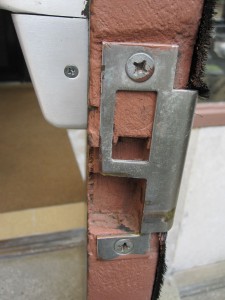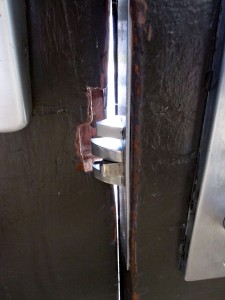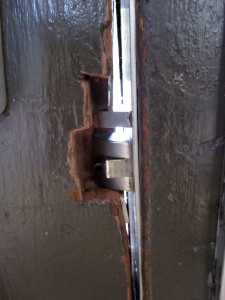 A couple of weeks ago one of my coworkers, Rich Conroy, took a phone call from someone with questions about open back strikes. Rich asked me to write a post that he could refer people to, and the hold-up was that I had to find a photo. Not the photo you see in a catalog (right), which usually shows the strike alone, but a photo of an open back strike in action. Try looking for one on Google Images and you’ll find a few graphics of the strike by itself, some open backed shoes, and plenty of open backed dresses, but no open back strikes in action.
A couple of weeks ago one of my coworkers, Rich Conroy, took a phone call from someone with questions about open back strikes. Rich asked me to write a post that he could refer people to, and the hold-up was that I had to find a photo. Not the photo you see in a catalog (right), which usually shows the strike alone, but a photo of an open back strike in action. Try looking for one on Google Images and you’ll find a few graphics of the strike by itself, some open backed shoes, and plenty of open backed dresses, but no open back strikes in action.
The other day I was walking through a university dorm and I saw just what I was looking for. It was a homemade open back strike and I’m not advocating creative hardware modifications, but I think it will help me explain why they’re used.
Here’s how NFPA 80 (2007) defines an open back strike:
3.3.121.2 Open Back Strike. A strike applied to the inactive leaf of a pair of doors and cut away at the back to allow either leaf to open or close independently.
An open back strike is used on a pair of doors, when one door has hardware that latches into the other door, AND the other door has hardware that can operate independently (not flush bolts). For explanation purposes, I’ll call the door with the strike the inactive leaf, and the other door the active leaf, even though both doors are actually active.
The “active” leaf typically has mortise panic hardware, but in the photo below it has a lockset (I know, I hate this application). The “inactive” leaf typically has a vertical rod panic. The purpose of the open back strike is to allow both leaves to operate independently, without using a coordinator. (If you’re not sure what a coordinator is I’ll address that in a separate post, but in a nutshell it coordinates the closing of the doors so that the inactive leaf closes before the active leaf.) If the pair in the photo below had no open back strike and no coordinator, the inactive leaf could be opened with some difficulty because of the latch engaged in the strike. It could then close in the wrong sequence and get hung up on the latchbolt of the lockset. This can also happen when a pair has an overlapping astragal with no coordinator – if the wrong leaf closes first, it sits against the astragal and doesn’t close properly.
But I digress. The open back strike allows the door with the vertical rod panic to open and close without conflicting with the mortise lock or mortise panic latchbolt. The door with the mortise lock/panic can also open and close without a conflict. Open back strikes can be standard strikes or electric strikes. NFPA 80 allows open back strikes on fire doors, where permitted by the AHJ:
6.4.4.4.1 Where permitted by the AHJ, pairs of doors not provided with an astragal shall be permitted to have labeled fire exit hardware and an open back strike installed on the inactive leaf, and either labeled fire exit hardware or any labeled latch capable of being opened by one obvious operation from the egress side installed on the active leaf.
So where do you use an open back strike? Only when all of the following conditions exist:
- Pairs of doors (never on a single door)
- The hardware on one leaf latches into the other leaf
- Both leaves have hardware that allows them to be independently operated (not flush bolts)
The most common application is mortise panic (w/open back strike) x vertical rod panic.
One more thing. You’ll notice in the 4th photo that the auxiliary deadlatch, the part projecting above the latchbolt, is fully projected even when the latchbolt is engaged in the strike. Deadlatching is a feature that will prevent “credit carding” of the lock, but the auxiliary deadlatch must be pushed inside of the lock in order for the deadlatching feature to work. If the strike is properly aligned with the lockset, the auxiliary deadlatch will ride on a solid area of the strike and be pushed into the lock, engaging the deadlatching feature. With the lock in the condition shown in the last photo, it’s easy to pry back the latchbolt and gain entry, since the deadlatching feature is not engaged.
So…clear as mud? If you have questions, leave a comment and I’ll try to improve the explanation. For the hardware gurus out there, if you can think of a way to better explain either of these 2 concepts, leave a comment. They’re tough ones!
You need to login or register to bookmark/favorite this content.









Agree with your comment, and let me add something;
NFPA 80 2007 edition has accepted the open back strike , while in 1999 edition , it dose not mentioned anything about it.
If you have a Mortise exit device x vertical rode exit device , you should use a coordinator.
The architect do not like to use the gravity coordinator, but prefer the soffit type.
I have never seen a spec mentioned special prep for the coordinator when used with vertical rod and even the hardware supplier always missing this request from the factory (if i am not wrong) for special prep.
However , you can not install concealed over head closer such as LCN 3033 with the body on the door leaf and you have soffit coordinator as the Closer arm will conflict with the coordinator.
So this will be another good application for the open back strike.
A disadvantage of the open back strike is that the architect do not like the cut-out on the leaf as you can see the latch .
I missed to say that the open back strike is handed and when purchase it with the lock , it must have the same handing as the lock(strike is handed by the active leaf RHRB or LHRB.
Do my eyes deceive me, or did the bottom latch miss the strike in the floor? Is that a deadbolt on the active leaf? WOW!!
Lori–You probably saw plenty of the open backed shoes and open backed dresses at the university, as well as on Google! I’m often amused at the images that Google “finds” for me when I’m searching for images for my blog, too!
Kathi
Yes, Google Images can be scary!!
Hello, Cirecast has the very condition in this post. We will use 2 8827LF SVU x EO devises with closers on both leaves. Both leaves will wind up as active when installed.The active leaf will be keyed and the passive leaf will have a dummy blank cylinder. The opening should look well balanced when installed. No coordinators and no bottom rods. We are also restoring some pretty old devises built by Von Duprin dating to the 1932 construction of he building. Maybe a small digital demo of the doors operating. Hope all is going well with you as well.
Peter Morenstein
Cirecast
If you’re looking for descent images of an opn back strike in action, check out this link to HMFExpress:
http://www.hmfexpress.com/tech-tips-open-back-strikes/
I had NO luck finding images on Google.